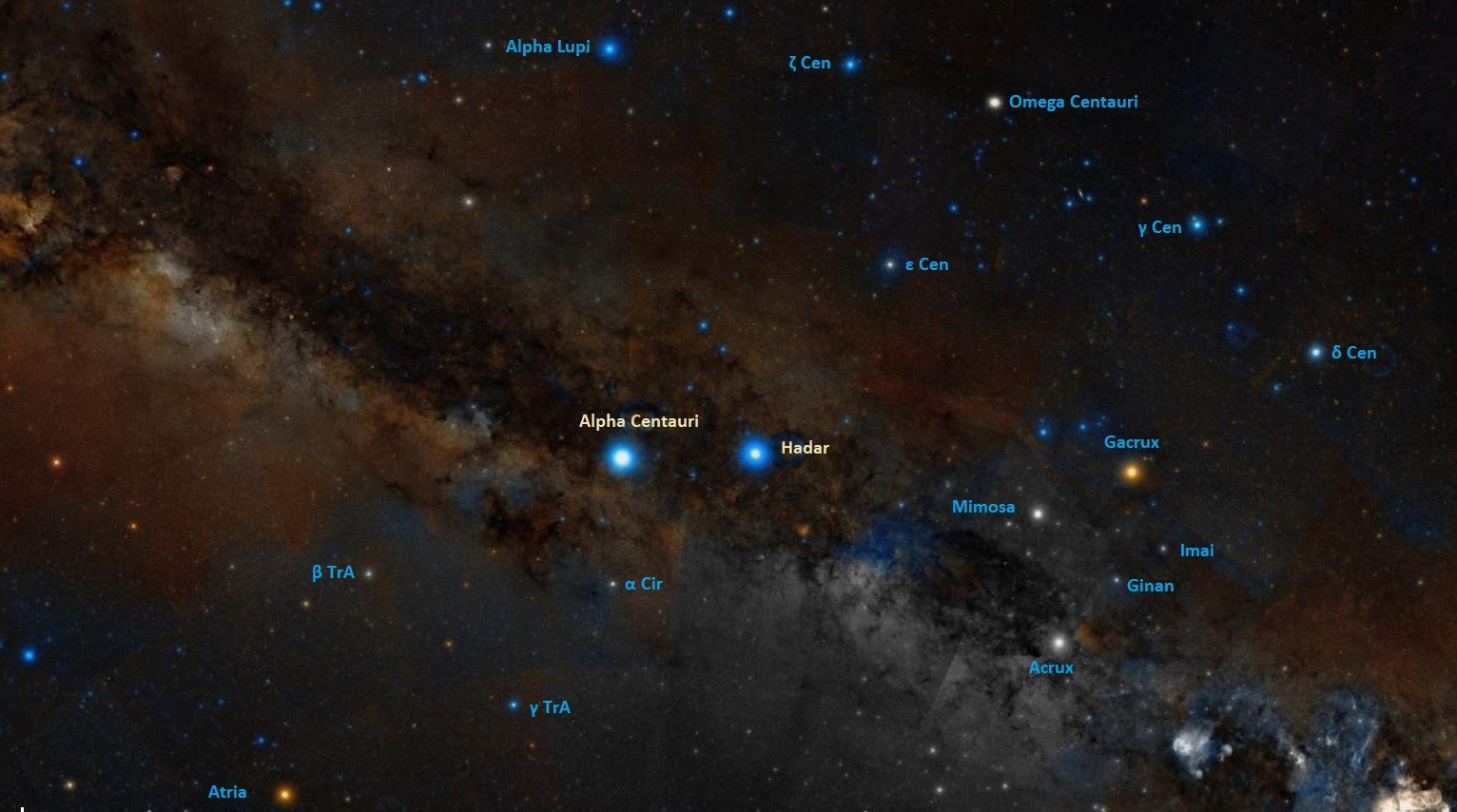Rigil Kentaurus, Alpha Centauri A (α Cen A), is a Sun-like yellow main sequence star located at a distance of 4.37 light years from Earth in the constellation Centaurus. It is the primary component of the Alpha Centauri star system, the nearest star system to the Sun and the third brightest point of light in the sky outside the solar system, after Sirius and Canopus. With an apparent magnitude of +0.01, Rigil Kentaurus is the individual brightest star in Centaurus, outshining Hadar and Toliman, and the fourth brightest star in the sky, after Sirius, Canopus, and Arcturus.
Star type
Rigil Kentaurus is a main sequence star of the spectral type G2V. It is a Sun-like star that exhibits coronal variability due to star spots coupled with the effect of rotation.
The star is slightly larger and more massive than the Sun, with a mass of 1.100 solar masses and a radius of about 1.2234 solar radii. With an effective temperature of 5,790 K, it is 1.519 times more luminous than the Sun. It has a projected rotational velocity of about 2.7 km/s and takes about 22 days to complete a rotation.
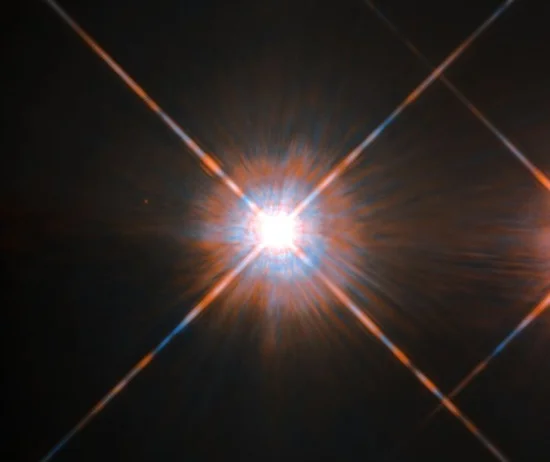
Rigil Kentaurus (Alpha Centauri A), image: ESA/NASA (CC BY 2.0)
The reported apparent magnitude of Rigil Kentaurus slightly differs from catalogue to catalogue. In the Bright Star Catalogue and the Hipparchos and Tycho Catalogues (1997), it is -0.01, while the 2007 Hipparcos (New Reduction) lists a magnitude of +0.1373. The Tycho-2 Catalogue gives a value of +0.137.
Star system
Rigil Kentaurus is the brightest component of the Alpha Centauri system, which also comprises Toliman (Alpha Centauri B) and Proxima Centauri (Alpha Centauri C). Toliman is a class K1V main sequence star and Proxima is a red dwarf of the spectral type M5.5Ve. At a distance of 4.244 light years, Proxima is the nearest star to the Sun.
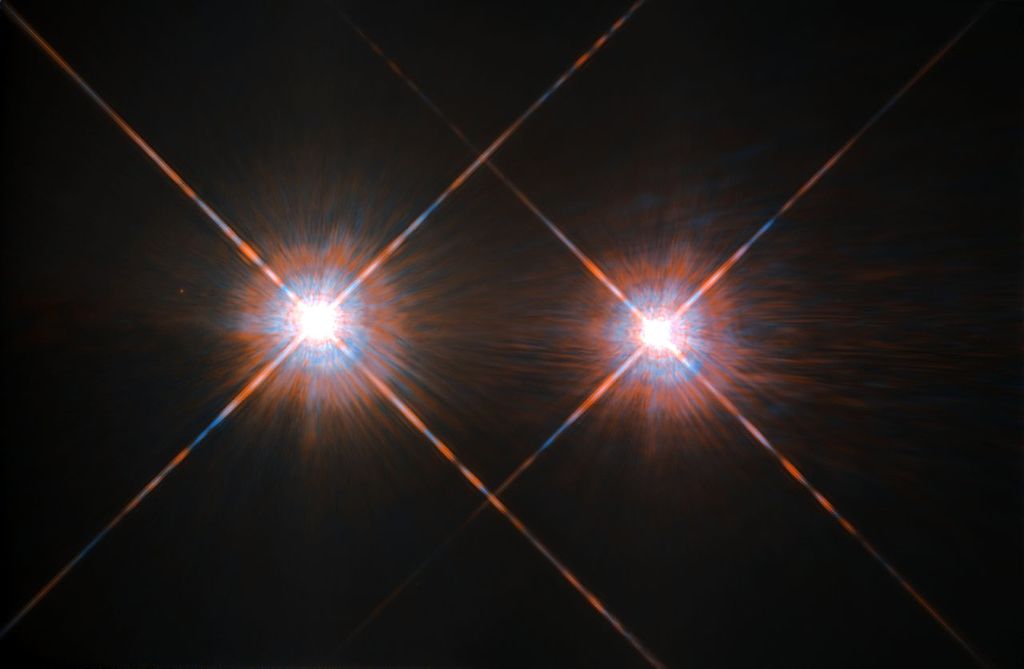
This NASA/ESA Hubble Space Telescope has given us this stunning view of the bright Alpha Centauri A (on the left) and Alpha Centauri B (on the right), shining like huge cosmic headlamps in the dark. The image was captured by the Wide-Field and Planetary Camera 2 (WFPC2). WFPC2 was Hubble’s most used instrument for the first 13 years of the space telescope’s life, being replaced in 2009 by Wide-Field Camera 3 (WFC3) during Servicing Mission 4. This portrait of Alpha Centauri was produced by observations carried out at optical and near-infrared wavelengths. Image: ESA/NASA (CC BY 2.0)
Together with the smaller, cooler and less massive Toliman, Rigil Kentaurus forms the Alpha Centauri AB binary star system. The two appear as a single star with an apparent magnitude of -0.27 to the unaided eye. They orbit around a common centre of mass with a period of 79.91 years and an eccentricity of 0.5179. Because they have an eccentric orbit, the distance between them varies from 11.2 to 35.6 astronomical units.
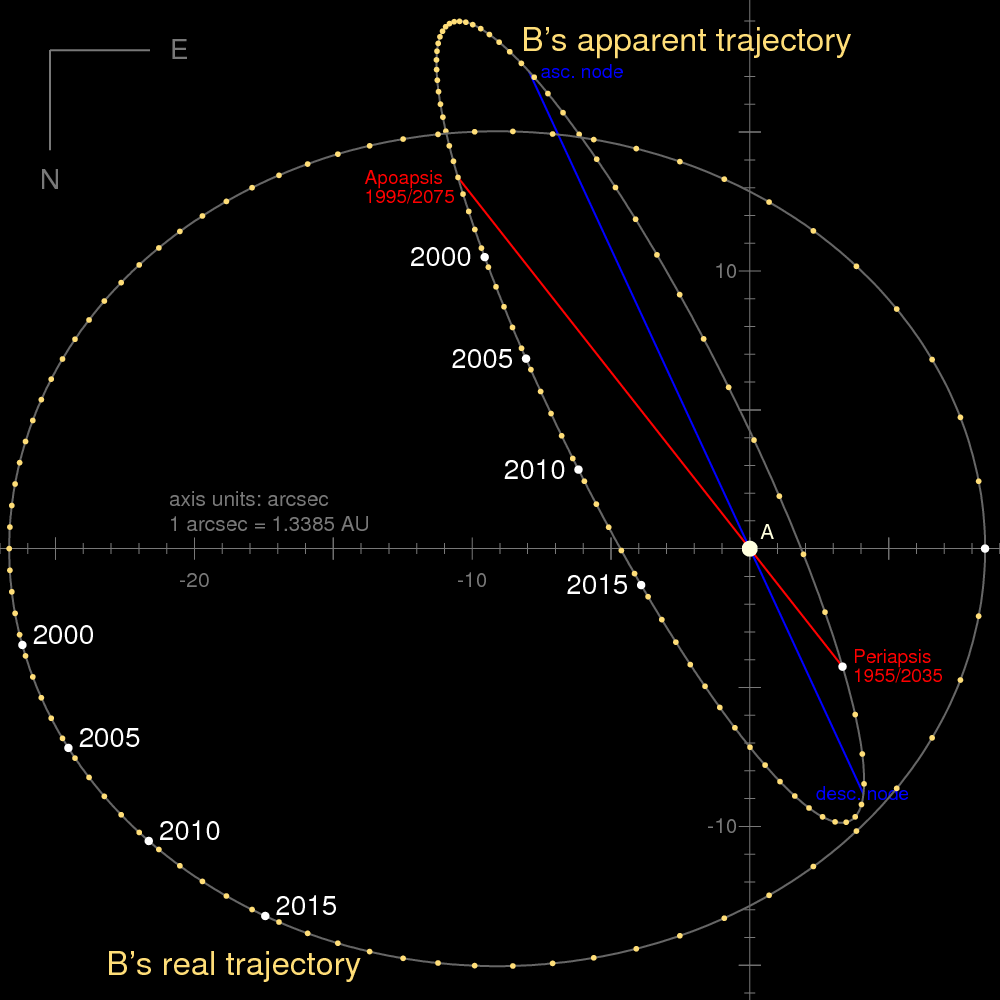
Trajectory of Alpha Centauri B relative to A (fixed to the coordinate origin) as seen from the Earth (inclined ellipse) and face-on (horizontal ellipse). The orbit parameters are taken from Pourbaix et al. (2002). The graph has been created with gnuplot based on data generated by solving Kepler’s equation.
Note 1: The time stamps refer to the motion as seen from Earth, i.e. delayed with respect to the true motion by the travel of light by about 4.4 years. North is down, as usual in many astronomical charts. Note 2: For simplicity, the points refer to steps of 1/80 of an orbit rather than to exact 1-year steps (which would be 1/79.91 of an orbit). Note 3: The ascending node is the point where B (with respect to A) penetrates the celestial plane and becomes more distant to Earth than A. Image: Wikimedia Commons/SiriusB (CC BY-SA 3.0)
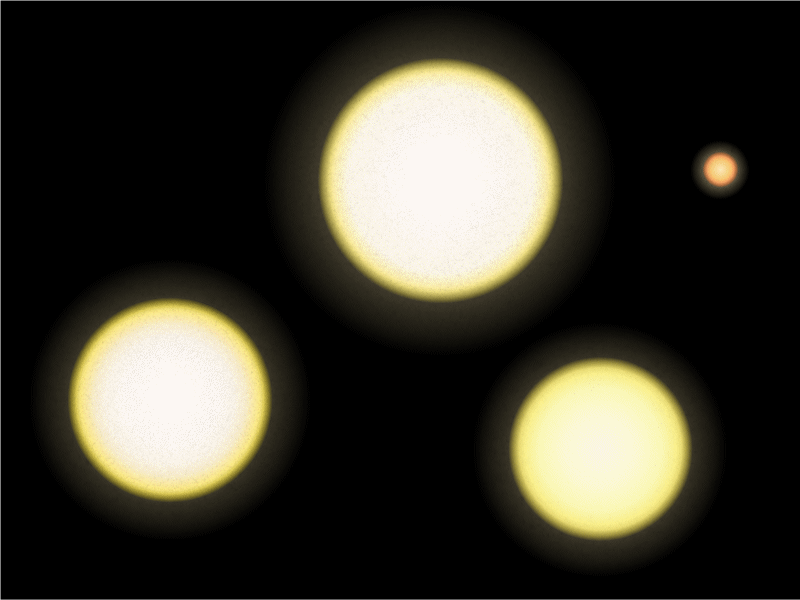
This diagram illustrates, from left to right, the relative size of the Sun, α Centauri A, α Centauri B and Proxima Centauri. Image: Wikimedia Commons/RJHall (CC BY-SA 3.0)
The apparent separation between the stars is always changing during their orbit. In 2019, they appeared 4.92 arcseconds apart and the separation increased to 5.49 arcseconds in 2020. The observed minimum separation was 1.7 arcseconds, while the maximum was about 22 arcseconds.
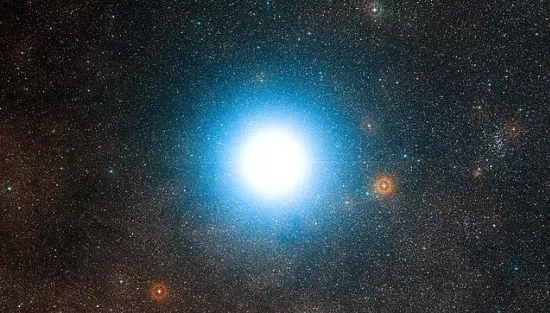
This wide-field view of the sky around the bright star Alpha Centauri was created from photographic images forming part of the Digitized Sky Survey 2. The star appears so big just because of the scattering of light by the telescope’s optics as well as in the photographic emulsion. Image: ESO/DSS 2
Proxima Centauri orbits the pair with a period of about 547,000 years at a distance that varies from 4,300 to 13,000 astronomical units. It is currently close to apastron (the widest separation).
Proxima is the only star in the Alpha Centauri system with confirmed exoplanets. The three planets, discovered in 2016, 2020 and 2022, are designated Proxima Centauri b, c and d. They are the nearest exoplanets to Earth. Proxima b is located in the star’s habitable zone.
To date, no planets have been detected around Alpha Centauri A. To be in the star’s habitable zone, a planet would need to have an orbital radius between 1 and 2 astronomical units.
Two planets were announced for Toliman in 2012 and 2013, but their existence has not been confirmed. The presence of the first one was ruled out within a year of the announcement after further analysis.
Facts
The binary nature of Alpha Centauri was discovered by Father Jean Richaud, a Jesuit priest, in December 1689, while observing a comet. The system’s proximity was confirmed by the Scottish astronomer Thomas Henderson, who made his observations at the Royal Observatory at the Cape of Good Hope in South Africa in 1832-33. Henderson measured the system’s parallax after the British astronomer Manuel John Johnson had reported the stars’ high proper motion. However, Henderson did not publish his results until 1839 because he thought the values were too high to be accurate. For this reason, even though Alpha Centauri was the first star to have its parallax measured, it is often cited as the second, because the German astronomer Friedrich Wilhelm Bessel released a parallax for 61 Cygni in 1838.
Rigil Kentaurus is one of the 58 stars that have a special status in the field of celestial navigation. It is one of three navigational stars in Centaurus. The other two are the fainter Hadar (Beta Centauri) and Menkent (Theta Centauri). The three stars belong to a group of 18 southern navigational stars with a declination between 30° S and 90° S. Other stars in this group are Acrux and Gacrux in the neighbouring constellation Crux, Canopus, Miaplacidus and Avior in Carina, Achernar and Acamar in Eridanus, Kaus Australis in Sagittarius, Peacock in Pavo, Shaula in Scorpius, Atria in Triangulum Australe, Alnair in Grus, Suhail in Vela, Fomalhaut in Piscis Austrinus, and Ankaa in Phoenix.
Name
The name Rigil Kentaurus (pronunciation: /ˈraɪdʒəl kɛnˈtɔːrəs/) is derived from the Arabic Rijl al-Qinṭūrus, meaning “the foot of the Centaur.” It refers to the star’s position in the constellation Centaurus. The name was originally used for the whole Alpha Centauri system and now it formally applies only to its brightest component, Alpha Centauri A. The system’s other traditional name, Toliman, is now formally used for Alpha Centauri B.
The name Rigil Kentaurus was approved by the International Astronomical Union’s (IAU) Working Group on Star Names (WGSN) on November 6, 2016.
Rigil Kentaurus has also been known as Rigil Kent or simply Rigil. The name shares the same origin as Rigel, the name of the bright blue supergiant at the foot of Orion.
Location
Rigil Kentaurus is very easy to find because it is part of the Alpha Centauri system, the third brightest point of light in the night sky. It is located near Hadar (Beta Centauri) and the Southern Cross, a bright southern asterism commonly used to find the south celestial pole.
However, Alpha Centauri is invisible to most northern observers. It lies in the far southern sky and never rises above the horizon for observers north of the latitude 29° N. From northern tropical latitudes, it only appears low above the horizon at certain times of year. South of the latitude 29° S, the star system is circumpolar, i.e. it never sets and can be seen year-round.
Alpha Centauri is at its highest point in the sky at midnight on April 24 and around 9 pm on June 8.
Constellation
Rigil Kentaurus is located in the constellation Centaurus. Stretching across 1,060 square degrees, Centaurus is the ninth largest constellation in the sky. It has been known since ancient times and is one of the ancient Greek constellations, first listed by the Greek astronomer Ptolemy in his Almagest in the 2nd century CE. With 10 stars brighter than magnitude 3.00, Centaurus is also one of the brightest constellations. It contains the third and 11th brightest stars in the sky, Alpha and Beta Centauri. It is also home to HR 5171 (V766 Centauri), one of the largest stars ever discovered.
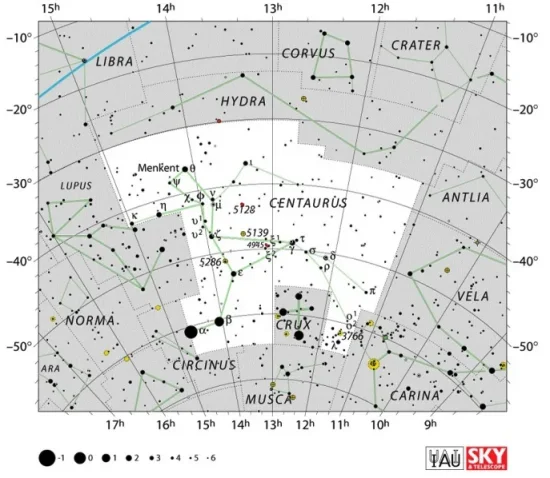
Centaurus constellation map by IAU and Sky&Telescope magazine
Notable deep sky objects in Centaurus include the bright, large globular cluster Omega Centauri (NGC 5139), the planetary nebula NGC 3918 (also known as the Blue Planetary or the Southerner), the protoplanetary nebula ESO 172-7 (the Boomerang Nebula), the bright starburst galaxy Centaurus A (NGC 5128), the irregular galaxy NGC 5253, the elliptical galaxy NGC 4696, the spiral galaxies NGC 4945 and NGC 4622, the polar-ring lenticular galaxy NGC 4650A, and the open clusters NGC 3766 and NGC 5460.
Despite its brightness and size, Centaurus is largely unknown to northern observers because it never rises very high above the horizon from locations in northern latitudes, if it appears at all. South of the equator, however, the constellation is circumpolar, i.e. it never sets and can be seen throughout the year.
The best time of year to see the stars and deep sky objects in Centaurus is during the month of May, when the constellation is particularly prominent in the evening sky. Centaurus can be seen in its entirety from locations between the latitudes 25° N and 90° S.
The 10 brightest stars in Centaurus are Alpha Centauri (mag. -0.27), Hadar (Beta Cen, mag. 0.61), Menkent (Theta Cen, mag. 2.06), Gamma Centauri (mag. 2.17), Epsilon Centauri (mag. 2.30), Eta Centauri (mag. 2.35), Zeta Centauri (mag. 2.55), Delta Centauri (mag. 2.57), Iota Centauri (mag. 2.73), and Lambda Centauri (mag. 3.13).
Rigil Kentaurus – Alpha Centauri A
| Spectral class | G2V |
| U-B colour index | +0.24 |
| B-V colour index | +0.71 |
| Apparent magnitude | 0.01 |
| Absolute magnitude | 4.38 |
| Distance | 4.37 light years |
| Parallax | 743 ± 1.3 mas |
| Radial velocity | −21.4 ± 0.76 km/s |
| Proper motion | RA: −3679.25 mas/yr |
| Dec.: 473.67 mas/yr | |
| Mass | 1.100 M☉ |
| Luminosity | 1.519 L☉ |
| Radius | 1.2234 ± 0.0053 R☉ |
| Temperature | 5,790 K |
| Metallicity | 0.20 dex |
| Rotational velocity | 2.7 ± 0.7 km/s |
| Rotation | 22 ± 5.9 days |
| Surface gravity | 4.30 cgs |
| Constellation | Centaurus |
| Right ascension | 14h 39m 36.49400s |
| Declination | −60° 50′ 02.3737″ |
| Names and designations | Rigil Kentaurus, Rigil Kent, Alpha Centauri A, α Cen A, Alpha1 Centauri, HR 5459, HD 128620, HIP 71683, LHS 50, PLX 3309.00, GCRV 8517, LFT 1127, LTT 5806, NLTT 37984, PPM 360911, TYC 9007-5849-1 |
